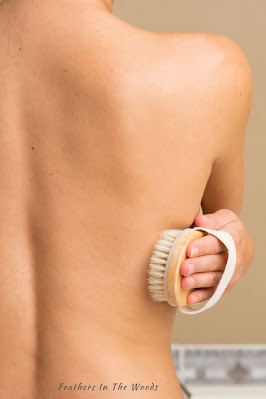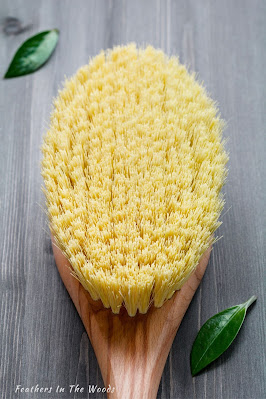For the last few months I have been doing something called dry brushing every day before I get into the shower. It's exactly what it sounds like! You brush your skin without using any oil, lotion or water. I know it sounds uncomfortable and well, 'scratchy' but it's really not!
Dry brushing is a technique that can help improve your skin along with your immune and lymphatic systems. To promote healthy skin, you must exfoliate it as much as you moisturize it. Everyone should consider including this method in their regular skin care routine.
It is simple to use, inexpensive, and something you can do in just about 5 extra minutes. While most people will do their dry brushing technique before getting in the shower, don’t feel like that is the only time you can try it.
The Purpose of Dry Brushing
The skin is your body's largest organ and it absorbs a lot of toxins as it protects your body from harm. That's why it's important to dry brush the skin every few days or so. Brushing the skin dry is effective at removing old layers of skin and allowing the growth of new cells. It can also help smooth out the appearance of cellulite.Dry brushing stimulates the nervous system, improves skin tone and can assist with proper lymphatic flow. Some people find it helps ease anxiety.
If you have certain skin issues, dry brushing might be able to help resolve them, though you should be careful if you have sensitive skin or any cuts or scrapes – definitely don’t brush over wounds or burns until they have healed completely! Handle injured skin with care!
Dry brushing is not for everyone though! If you have psoriasis, eczema or rosacea, dry brushing could be too harsh for your skin. Speak to your doctor before deciding to try dry brushing in these cases.
How dry brushing detoxifies the skin
The body detoxifies harmful substances itself, but unfortunately those often come to the skins surface in the form of sweat. The skin removes a rather large amount of waste through sweat; however, a lot more toxins are absorbed through your skin every day. So this is sort of a two way street!For clean, healthy skin, everyone is encouraged to shower daily and use some type of soap. Of course, the harsher chemical cleansers are, they more risk you have of actually stripping important oils from your skin leaving it dry or irritated. For that reason you'll want to use a mild, natural body wash or soap.
Your skin is constantly renewing itself and you are shedding skin cells all day every day. In fact, you lose on average 30,000 - 40,000 skin cells an hour! Dry brushing your skin regularly can help remove these now excess skin cells without using harsh chemicals. Removing these excess cells helps to also remove the toxic substances that reside on the top layers of our skin.
When you remove accumulated layers of dead skin cells, you allow room for the growth of new skin. Dry brushing makes it easier for the body to produce new skin cells and repair damaged tissue.
The soothing aspect of dry brushing
Dry brushing is a soothing practice for many people. It can be a rythmatic, almost hypnotic process that some people find calming. Many people find it eases anxietySome brushes have very soft bristles that are gentle on dry or sensitive skin. It is meant to be done gently to avoid damaging the skin. The skin is more likely to shed when it's dry, so it's best performed before or after a shower.
Dry brushing is sometimes done as a prelude to massage. The website Ballaura talks about how dry brushing is used to prepare the nervous system for the deep stimulation and relaxation of massage on the muscles.
Some people have also seen positive effects with loose skin. If you are losing a large amount of weight and concerned about loose skin, try dry brushing every day to see if it makes a positive effect.
Choosing a dry brush
When purchasing a brush you'll want to feel the bristles first. Make sure they do not scratch your skin in a painful way. You might want to try them on the sensitive underside of your wrist first to make sure they are not too hard. The bristles should be flexible and not irritating on your skin.
You can find find dry brushes with soft, medium or hard bristles so choose one based on your skin type or comfort level. The more sensitive your skin, the softer bristles you should use. As a dry brush won't last forever, you should probably start rather soft and as time come to upgrade you can go with a stiffer bristle if you'd like.
I prefer a natural bristle brush but many different types are available. Preferably you'll purchase one from somewhere that you can actually feel the bristles first as opposed to ordering online and hoping you both agree on what a medium brush is.
A brush with a handle works better for some people while other prefer one that fits in their hand. Either way, pick a brush with a strap or some other type of hook so you can hang it after use. You'll want to wash it with mild soap and warm water after each use and hang it to dry.
How to dry brush skin
Starting at your feet, brush upwards along your skin in clockwise motions. Move up your calves, then up the thighs brushing towards the lymph nodes in the groin area. Brush the torso and back with the clockwise movements going up towards the armpits. Brush the arms last starting at your fingertips and heading towards the armpits.
Use lighter pressure on delicate areas like inner thighs and near the armpits. Do not use the same brush on your face....in fact, many practitioners do not dry brush the face at all! If you decide you want to include your face though, get a very soft brush that made for the face.
Dry brushing is best done right before taking a shower as the cool water will help to clean away any loosened skin cells that don't brush off. Moisturize afterwards.
Start off dry brushing once or twice a week and gradually increase the days till you are brushing before every shower.
When dry brushing is bad
Dry brushing is a practice meant to gently stimulate the skin, not buff it off like a belt sander! It should never been done aggressively or with an exceptionally stiff bristled brush. If you are finding your skin feels irritated or looks red for more than a few minutes after dry brushing, then you should switch your brush for a softer one.
Never dry brush over sunburned skin, irritations, cuts or scrapes, rashes, brush burn or anything else out of the ordinary. As mentioned above: If you have psoriasis, eczema or rosacea, dry brushing could be too harsh for your skin...see a Dr before starting it.
I have found that the longer I've been dry brushing the quicker it goes. The little bumps I get on the back of my arms and inner thighs are practically gone now (they looked like little pimples but never swelled up or got infected like acne) and the ingrown hairs I get after shaving my legs have not come back at all!
I would like to say my cellulite looks better, but I didn't take before pictures so that might just be wishful thinking. Just being honest! Even if the cellulite is still the same though, the texture of my skin feels softer. I imagine the dry brushing helps moisturizing creams to absorb better...which means now I'm actually getting my moneys worth from them! That's a benefit, right?
~L
Related reading: Want to learn how to Make your own skin healing salves with Calendula?
Want gardening and healthy living information sent right to your email weekly? Click right here to join my list and get new posts sent directly to you the day they're published!




No comments:
Post a Comment